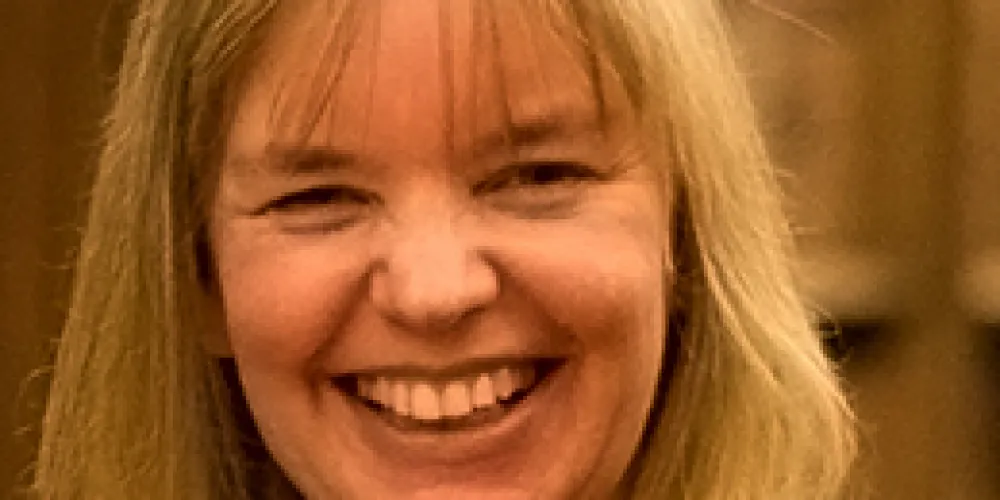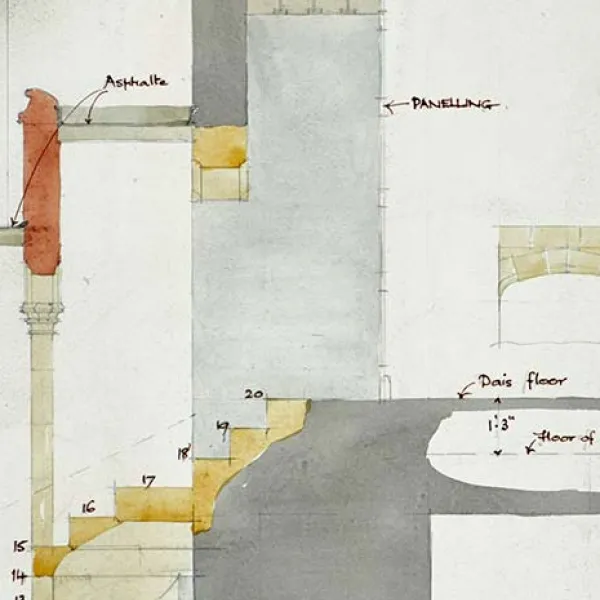The Archive is open to all those who have an interest in the history of the College, the Cathedral, the estates, and all the men and women who have worked and studied at Christ Church.
Housed in one of Christ Church's former brewhouses, the Archive is principally the repository for the administrative records of the College and Cathedral. We aim to maintain and consolidate those collections in order to reflect and illustrate our history. The archive is our corporate memory. As far as possible, subject to a few provisos, the records are available for research.
Contacting the Archivist
All enquiries relating to the content of the Archive, conditions of use or appointments should be addressed to the Archivist, Judith Curthoys.
The Archivist
Christ Church
Oxford
OX1 1DP
(+44) (0)1865 276171

An appointment is always necessary, but letters of introduction are not. The archivist understands that many researchers, particularly those working on local history or family history, may not have formal college or university affiliations. If you are unfamiliar with archival material, please ask for assistance; the Archivist is always happy to help.
The archive is open to external readers from Tuesday to Thursday. Normal office hours apply on Tuesdays and Wednesdays, and until lunchtime on Thursdays. Please note that the readers' space is up a very steep staircase. If you have mobility problems, please tell the Archivist: arrangements can be made for documents to be read in the library.
Visitors should go to the Porters' Lodge at Tom Gate and ask the duty porter to ring through.
-
History of the Archive
Until the 1960s, there was no single archive repository at Christ Church. The records of the Dean and Chapter were kept in a small Muniment Room over the Chapter House; the deeds and other estates papers were retained in the Treasury where they would have been in daily use; the Common Room held and maintained its own records, as did the other administrative departments until at least the 1970s.
In 1772, part of the cathedral cloister was converted into a Muniment Room - the designs for its sash windows are in the Archive - but in 1871, George Gilbert Scott returned the cloister to its late medieval state and the Archive was ejected, presumably to the relevant offices.
When Dr Geoffrey Bill was employed in 1950 to catalogue the Treasury's deeds, one of the rooms in Peckwater Quad was set up to accommodate the papers on which he was working. This was always a temporary solution, however, and when it was decided to build on the old Coal Yard, a new muniment room was always part of the plan.
In 1968, Powell and Moya incorporated a space for the Archive in the basement of Blue Boar Quad. Dr Bill disapproved of this location from the start; basements are never good places for archives. He suggested a number of possible sites, including the room in Tom Tower beneath the bell and the rooms beneath the Hall (now the Law Library). His ideas were not implemented and his fears proved correct.
The environmental conditions in the Blue Boar semi-basement were not good and, by the early years of the C21, with the addition of records not expected by Bill, the Archive was full. With the refurbishment of the Quad in 2009, the collections were moved into the old sixteenth-century brewhouse which has been adapted to keep the records in good condition for many years to come with good security and effective environmental controls.
-
Useful Publications
E.G.W. Bill, Education at Christ Church, 1660-1800 (Oxford, 1988)
E.G.W. Bill and J.F.A. Mason, Christ Church and reform, 1850-1867 (Oxford, 1970)
C. Butler (ed.), Christ Church: a portrait of the House (London, 2006)
J. Curthoys, Cows and Curates: the story of the land and livings of Christ Church, Oxford (London, 2020)
J. Curthoys, The King’s Cathedral: the ancient heart of Christ Church, Oxford (London, 2019)
J. Curthoys, The stones of Christ Church: the story of the buildings of Christ Church, Oxford (2017).
J. Curthoys, The Cardinal's College: Christ Church, Chapter and verse (London, 2012)
N. Denholm-Young's Cartulary of the medieval archives of Christ Church (Oxford, 1931)
David Fletcher, The emergence of estate maps, Christ Church, Oxford 1600-1840 (Oxford, 1995)
Joseph Foster, Alumni Oxonienses, 1500-1714 (Oxford, 1891); Alumni Oxonienses, 1715-1886 (Oxford, 1888); Oxford Men, 1880-1892 (Oxford, 1893)
W.G. Hiscock, A Christ Church miscellany: new chapters on the architects, craftsmen, statuary, plate, bells, furniture, clocks, plays, the library, and other buildings (Oxford, 1946)
The web-pages of the Oxford University Archive contains all sorts of useful information:
Most other colleges have archives and information on these, with an FAQ page, can be found at:
The Archive Collections
-
Introduction
The Archive is one of the largest college archives in Oxford. The records date from the 12th century to modern times.
Much of the catalogue is now on-line here: https://christchurch.epexio.com/ The entries are still, in some cases, quite basic and will be given volume over time. Others are much more detailed.
Other sections of the catalogue will be added in the near future. Not everything is available for consultation and there is an indication of the availability of any item on the catalogue entry. There are a few items which will not be included on the public-facing catalogue for reasons of data protection or business security.
Please feel free to ring or e-mail to ask any questions about the content of the Archive.
The Archive does not hold any diocesan records. These may be consulted at the Oxfordshire History Centre. Records relating to living people are subject to the terms of the UK GDPR/DPA 2018 and its subsequent amendments.
The Archive consists of a number of series, to which there are guides included in the online catalogue.
-
Records of the Dean and Chapter
including:
- Chapter Books and minutes from the foundation
- Accounts
- Service sheets from the late C19, including those for special services
- Records of the choir and the cathedral school (limited)
- Installation documents for deans and canons
- Registers of baptisms, marriages, and burials
-
Deanery papers
including:
- Admissions records
- Personal papers of the deans (limited)
- Papers relating to benefactions, gifts and trusts
- Early material on Cardinal College, including the accounts of Robert Amadas, royal goldsmith, and the 1525 endowment of property.
-
Governing Body papers
including:
- Minutes from 1867
- Committee papers
- Buildings records
- Originally a sub-section of Governing Body papers, this series comprises records dealing with building projects, and maintenance and repairs. The Archive also holds a number of architectural drawings from the C18 to the present day.
- Clubs, society, and personal papers
- Minute and rule books of clubs and societies
- Theatrical programmes and related correspondence
- Papers relating to and by individual members of Christ Church.
- This series includes the large collections belonging to:
- Hugh Trevor-Roper (Lord Dacre);
- Tom Driberg (Lord Bradwell) MP;
- and smaller collections relating to the work of:
- Geoffrey Drage MP;
- Nigel Lawson MP (Lord Lawson of Blaby);
- Cyril Evelyn (poet);
- Ralph Hewins (biographer);
- Dimitri Obolensky.
The collection of papers relating to the Phillimore family of judges and lawyers has been transferred from the library to the Archive, and will undergo detailed listing as soon as possible.
Please note that permission to consult and/or publish anything from the papers of Hugh Trevor-Roper must be obtained in advance from Professor Blair Worden, Lord Dacre's literary executor
Permission to publish material from the Driberg collection must be sought from Ms Georgia Glover, David Higham Associates, 5-8 Lower John Street, London, W1F 9HA.
The large collection of papers relating to Lord Portal and the 2nd World War are retained by the Library.
-
Common Room records
Minute books, accounts, correspondence, etc. relating to the administration of the Senior Common Room. NB. This section includes a considerable amount of material by Charles Dodgson from his period as Curator of Common Room but material relating to Dodgson as Lewis Carroll, author of Alice's adventures in Wonderland, is held by the Library.
-
Photographs
Albums and loose photographs belonging to college clubs and societies, and topographical images. The Boat Club is particularly well-represented, and we hold matriculation photographs from 1947.
-
Manorial documents
As part of its endowment, Christ Church was given the lordship of around 20 manors in England. Many of these have been sold with the landed estate over the years although a few remain in Christ Church's possession. The records held in the Archive are, on the whole, post-medieval.
-
Treasury papers
The Treasury papers form approximately half of the Archive, and was the section initially catalogued by Dr Geoffrey Bill in the 1950s. As a consequence, it contains items which would not necessarily be considered Treasury (estates bursary) papers today. Principally the section deals with the financial administration of the college and cathedral, and particularly with its landed estate. As such it contains terriers and surveys, rent books, conveyances and leases, etc. However, it also includes material like the collections books, which record the termly reading of undergraduates from c.1700 to the late C19; the correspondence of George Chinnery, an undergraduate in the first decade of the C19; the building accounts of Tom Tower and Peckwater Quad, etc.
-
Steward's Office
The Steward's Office (domestic bursary) was created in 1867 and took over from the Treasury the administration of accommodation, catering, conferences, etc. Its records include those of special dinners, student room allocations, and domestic staff.
-
Censors' Office records
The Censors are the academic administrators of the collegiate part of Christ Church. Many of its records are subject to the Data Protection Act and, as such, are not available for consultation. The section contains some material relating to the appointment of senior staff, and all the files relating to undergraduate and graduate members from c.1867. Until the 1930s, these files are often extremely thin. Rarely do our records hold any information on wives, mothers, or children, or on post-Christ Church careers.
-
Development and Alumni Relations
A relatively new department, the Development and Alumni Relations Office exists to keep in touch with members once they have left Christ Church, and to raise funds. Like the records of the Censors' Office, much remains subject to the Data Protection Act. Most of the material in the Archive from this office relates to surveys of old members and fundraising literature.

